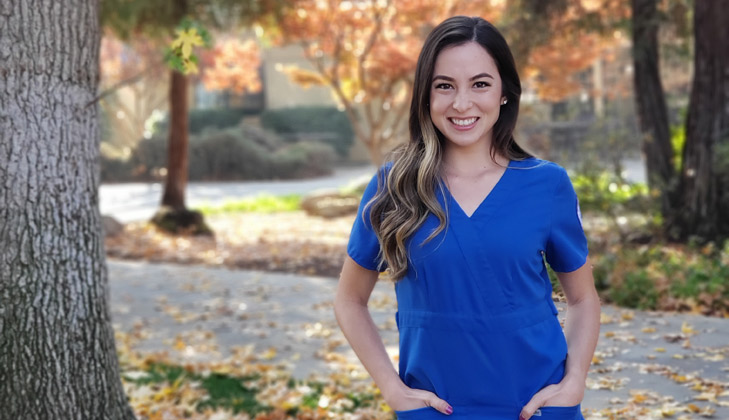Fifth-semester nursing student Bernadette Romero was just two months shy of graduating from Fresno State’s nursing program when COVID-19 put a stop to in-person clinicals in March.
At that point, Romero needed to complete just 40 more clinical education hours required by the State of California. With many of these clinical rotations completed at local hospitals, faculty in the School of Nursing had to quickly adapt new plans in order to get the students on track to graduate.
“We knew the importance of providing an alternative way for students to complete their remaining clinical hours for the semester,” said Dr. Sylvia Miller, chair of the School of Nursing at Fresno State. “We are also aware of the nursing shortage in the Valley, and the heightened importance of having our students graduate on time.”
This led to the implementation of Lippencott CoursePoint+, a virtual simulation learning tool that applies theoretical concepts to real-life clinical scenarios. Instead of working directly with patients, students were now working through a computer screen with simulated scenarios and patients. The once bustling clinical labs on campus went dark, but the learning did not skip a beat.
A total of 300 students in the bachelor’s program, from first-semester students to fifth-semester students, were exposed to this adapted virtual modality. Of that number, 57 are expected to graduate this month with their bachelor’s degrees in nursing, including Romero.
In the virtual course, each clinical day began with an introduction to the pediatric or adult patient who is presented with varying illnesses. From there, the students work step-by-step through the simulation encounter, as if it were in-person.
“The students are required to receive 90 to100% on each virtual patient encounter before they can move on to the next step,” said Dr. Lynn Jakobs, assistant professor in the School of Nursing. “They can repeat the simulation as many times as necessary. Once the simulation is complete, the students log into Canvas to participate in a discussion board with questions related to the scenarios they just completed. The questions are designed to enhance critical thinking and to stimulate discussion among students.”
The clinical day ends with a two-hour debriefing session via zoom with the students and clinical instructor. Jakobs said this element is the most important piece of the puzzle, as it allowed the clinical instructor to work directly with students to piece together and correctly diagnose the patient.
Romero said virtual simulation has been a great way to test her knowledge of important skills related to priority of care, critical thinking and communication with patients — while also having the chance to learn effectively.
“Through the virtual simulation, I was able to complete any tasks that I would do in a clinical situation, but in this case, I was allowed to repeat the simulation as many times as needed in order to get 100%,” Romero said. “It is programmed to give you a percentage of how well you perform as a nurse and any mistakes made through virtual simulation are reported at the end. This helped me understand how I can improve as a nurse in that situation and reinforce my practices. Virtual simulation is a great tool to build our confidence before we become registered nurses.”
In April, the California Department of Consumer Affairs announced a waiver that would automatically reduce the clinical requirement of direct patient care for nursing students from 75% to 50%. Training through simulation and labs, like what the School of Nursing implemented, has also been approved.
Romero said that without the waiver, she is not sure she would have been able to graduate on time. She is now on her way to completing all her required hours and has just been offered a registered nurse position at Valley Children’s Healthcare in the oncology/hematology unit.
“With a humble heart,” Romero said, “I will be starting as soon as I pass my licensing exam.”
To learn more about the School of Nursing, visit fresnostate.edu/nursing.





